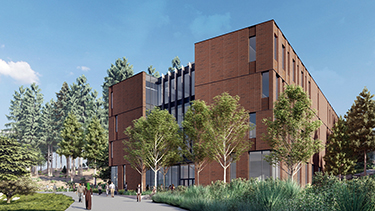|
Subscribe / Renew |
|
|
Contact Us |
|
| ► Subscribe to our Free Weekly Newsletter | |
| home | Welcome, sign in or click here to subscribe. | login |
Architecture & Engineering
| |
 |
April 15, 2021
New design requires thoughtful programming
Lease Crutcher Lewis

Aske
|
As Seattle’s higher education institutions compete with other regions to attract the “best and brightest” students — the ones who will find the cure for our most challenging diseases or invent the technology that revolutionizes the way our community functions in the future — they must do so with talented faculty, noteworthy programs and with state-of-the-art lab and learning space.
In Bothell, Cascadia College and University of Washington Bothell joined forces, and funds, to create an educational resource that is fully integrated to educate their students in science, technology, engineering and math. Once complete, the 80,000-square-foot facility will feature classrooms, labs, collaboration space and facilities for biology, chemistry and physics. One of the goals of the project is to build a facility with the most instructional space possible, so more students from both institutions have access to educational resources.
After the successful completion of the Hans Rosling Center for Population Health — by Lewis and UW Seattle — Lewis has teamed with a new partner on this project, Mithun, to implement a similar integrated approach to deliver a state-of-the-art facility with the largest instructional space possible for UW Bothell and Cascadia College stakeholders
TRUSTING THE PROCESS
While the institutions share other space on campus, STEM 4 will be the largest and most complex jointly used facility and requires thoughtful programming and design solutions. These solutions have evolved from skillfully led working sessions with a variety of stakeholders. Those stakeholders needed to be aligned around not just their institutional needs, but also for the overall success of the project.
As a progressive design-build team, Lewis, Mithun, their trade partners and consulting engineers have worked with those stakeholders to identify what success looks like, then design and build a project that specifically meets those goals — eliminating wasted resources, optimizing time and money.
Since the entire team is aligned to meet the owner goals, each specialty is working towards a shared vision of success — including building size — meaning there is no need for redesigns, rework or value engineering later in the process. Now, every resource, be it funding, expertise or time is focused on providing the best possible value for the project and client.
IDENTIFYING POSSIBILITIES
To help University of Washington and Cascadia College stakeholders identify and understand the right program size for their building, the design-build team collected and compared historical cost data from similar higher education facilities in the area. Then, the team adjusted the data to account for escalation, location and changes in building codes to create reliable benchmarks and help set realistic expectations for the owner team, while setting target values to guide the design-build team.
Aligning the program and building size to the budget before design begins gives the team the right starting point make strategic design and programming decisions, while eliminating the need to value engineer important aspects of the building later in design.
HELPING OWNERS
Through transparent collaboration between the design-build team and the institutions, the team will proactively track and manage risks throughout the project, meaning unused contingency can be reinvested back into the building. By identifying and mitigating risks early at the STEM 4 project, we were able to develop the confidence with the owners to design a larger building than the initial benchmarks indicated would be possible. The team also maintains certainty that the project will be finished on budget while maximizing the amount of new lab space added to the campus.
The design-build team considered several building sizes and footprints to understand how they fit the site and the cost implications for each option. Since maximizing instructional square footage was a primary goal for our owners, the design-build team presented several options with varying building size; the bigger buildings met the owner goals, but also put a small portion of the interior buildout at risk — meaning some of the finishes would be funded through contingency that would be reinvested in the building as design and construction progressed.
In a traditional delivery method, project risks are divided amongst each stakeholder and trade partner. To manage risk, each stakeholder holds their own contingency to cover their risk throughout the project. Typically, there is little team alignment on managing that risk, it is up to each individual partner to manage risks associated with their scopes.
However, a progressive design-build delivery allows all stakeholders — including the owner, design-build team and trade partners — to combine and manage risk and contingency together. The UW Integrated Design-Build contract takes this a step further and creates a Risk Reward team comprised of the builder and certain designers and trade partners. The team puts their fee at risk to incentivize everyone to work towards a common goal to get a proportional reward. By doing so, the team can more effectively manage risk and reinvest contingency back into the project, rather than return that funding as savings too late to be meaningfully invested into the building.
Together, the institutions and the design-build team collaborated to settle on a base program that maximized the size of building with some level of the interior buildout at risk, understanding that through thoughtful risk management, the team could likely reinvest the funds later in the project.
The design-build process has proven to be an important tool for higher education institutions looking to get as much building as possible for their funding, while tailoring the program to the unique needs of the students, researchers and faculty who will use it. The benefit comes from constant communication, a shared vision and complete transparency from the entire team.
The UW Bothell and Cascadia College STEM 4 building is set to complete in the fall of 2023 and will provide both institutions with a building that is 12% larger than the historical benchmarks indicated, with more instructional space, serving an additional 72 full-time students year after year — meaning more lab, classroom, collaboration and faculty space for both institutions. The project is another example of how innovative project delivery can have a direct and positive impact on fulfilling the mission of higher education.
Brian Aske is the education market director at Lease Crutcher Lewis and past president of the Northwest region of the Design-Build Institute of America.
Other Stories:
- Seattle’s U District housing boom: is there room for it?
- Sourcing regional materials for higher ed
- Early-stage design helps Hermanson with UW center
- How to make master plans that work
- The post-pandemic educational learning curve
- The evolution of campus, a new normal for higher education
- Sustainable student housing building design for higher education
- The evolving building delivery models at higher education institutions



